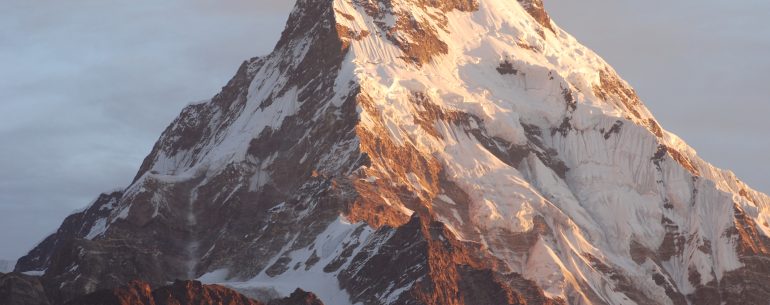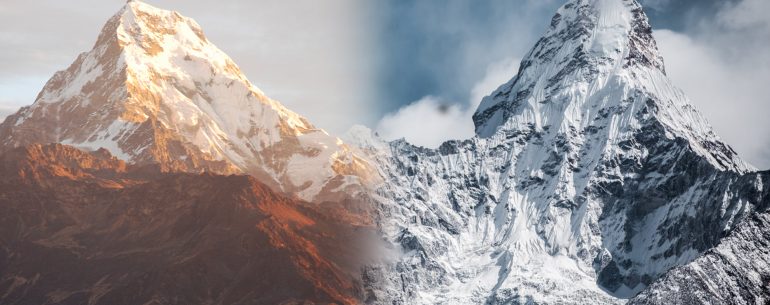There are two major factors to weigh as you decide when to go to Nepal: crowds and weather. As a general rule, the better the weather, the more people come to Nepal to go trekking. During the high tourist season in October and November, flights and hotels are fully booked and hotels and trails in the hills can be horrendously busy.
During autumn the nights are cold in the mountains, but the bright sun makes for pleasant day temperatures – in the high 20s° C, falling to 5° C at night, between 2500 meters and 3500 meters. At higher altitudes temperatures range from about 20° C down to -10° C. Mornings are usually clear with clouds building up during the afternoon, disappearing at night to reveal spectacular starry skies. During winter it is about 10 degrees colder. Early December usually has a lull, but this is also a good trekking season. The Christmas period is cold, but this is the holiday season in Japan and Australia and these nationalities dominate flights and hotels. High passes, especially Thorong La(5416m) on the Around Annapurna trek Everest Region; Kongma La Pass(5545m), Chola Pass (5335m) and Renjo Pass 5420m and Laurabina Pass(4600m), Ganja La Pass(5106m) on the Gosainkund trek are usually closed from late November to March. February is still cold; though less so as the spring trekking season of March and April approaches. The Middle Hills, especially around Pokhara, are full of dust and haze in April and May, but the high country is usually clear. Trekking tapers off in the heat of May except at high elevations.

The monsoon is a good time to visit Kathmandu, but there are few trekkers among those who come. A monsoon trek is possible if you are willing to put up with the rain, leeches, slippery trails and lousy mountain views. Flights operate throughout the monsoon to Lukla, Jumla and Jomsom, so it is possible to fly in and trek above the leech line. Many of the new treks to recently opened restricted areas are good summer treks. Mustang and Simikot are partially in the Himalayan rain shadow; so trekking conditions are good throughout the monsoon season. Most of the restricted area treks are impossible during the winter season. 
Nepal has four distinct seasons. Spring, from March to May, is warm and dusty with rain showers. Summer, from June to August, is the monsoon season when the hills turn lush and green. Autumn, from September to November, is cool with clear skies, and is the most popular trekking season. In winter, from December to February, it is cold at night and can be foggy in the early morning, but afternoons are usually clear and pleasant, though there is occasional snow in the mountains. Because Nepal is quite far south (at the same latitude as Miami and Cairo) the weather is warmer and winter is much milder at lower elevations, including Kathmandu at 1400 meters. It rarely snows below 2000 meters. The monsoon in the Bay of Bengal governs the weather pattern. The monsoon creates a rainy season from the middle of June to the middle of September. It is hot during the monsoon and it rains almost every day, but it is a considerate rain, limiting itself mostly to the night. During this season, trekking in most of Nepal is difficult and uncomfortable. Clouds usually hide the mountains and the trails are muddy and infested with leeches. It usually does not rain for more than one or two days during the entire autumn season from mid-October to mid-December. During winter and spring there may be a week or so of rainy evenings and occasional thunderstorms blanket the hills with snow. The Himalaya makes its own localized weather, which varies significantly over a distance of a few km. Despite the sanguine assurances of Radio Nepal that the weather will be “…mainly fair throughout the kingdom”, always expect clouds in the afternoon and be prepared for occasional rain. Most of the precipitation in the Himalaya occurs during the summer monsoon. There is less snow on the mountains and on many of the high trails during winter. Everest itself is black rock during the trekking season, becoming snow-covered only during summer. There are always exceptions to this weather pattern, so be prepared for extremes. Winter snowstorms in December and January may make an early spring pass crossing difficult and can present an avalanche danger, especially on the approach to the Annapurna Sanctuary. In Kathmandu, spring and autumn days are comfortable and the evenings are cool, usually requiring a light jacket or pullover. Winter in Kathmandu brings cold foggy mornings and clear evenings, but pleasant day temperatures with brilliant sunshine most days after the morning fog has lifted. It never snows in Kathmandu, though there is frost on cold nights in January and February. The hottest month is May, just before the rains start. Temperatures in the Everest Region average 20 to 30° F (10 to 15° C) colder than the above figures up to about 14,000 feet, the highest point reached on a short Everest trek. Near Pokhara, temperatures are 5 to 10° F (3 to 5° C) warmer than Kathmandu. Remember that it will often feel quite cold because you will be outdoors all day.
FOUR MAJOR SEASONS
Autumn (Mid September to November): following the monsoon the skies are generally very clear, the days warm and the evening cool. This makes an ideal time to trek or climb at higher altitudes. This is Nepal most popular season.
Winter (December to February): Generally, you enjoy the clear skies with crisp days but cold night at higher altitude. A great time to trek one or two week lower and mid altitude trails, where the temperature still remains pleasant and with fewer trekkers on the trail. Spring, March to Late May: This season presents a flora spectacular with the blossoming of the giant rhododendron, the day are warmer which makes higher altitude trekking in particular more comfortable. Summer June to early September: This is the ideal time for traveling in the INDIAN, TIBETAN HIMALAYA and in Nepal, Upper Mustang, Dolpa Upper, Manang Nar Phu. As the regions are generally shadowed from seasonal rain. Nepal experience monsoon rains from late May through to august so this season is unsuitable for Trekking in Nepal.




Leave a Reply